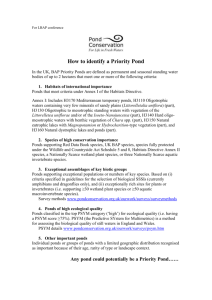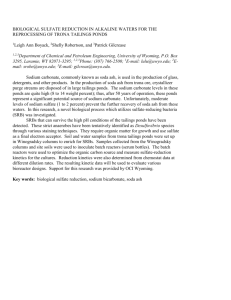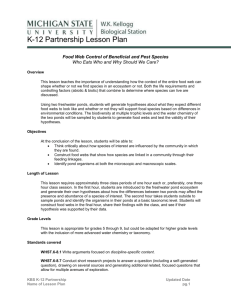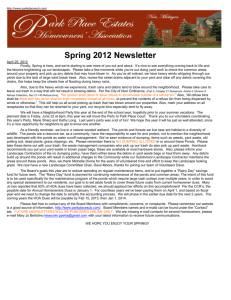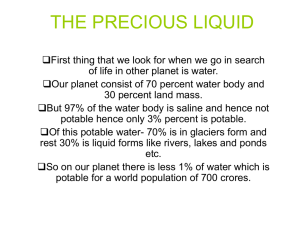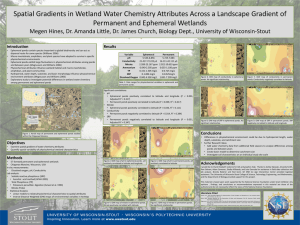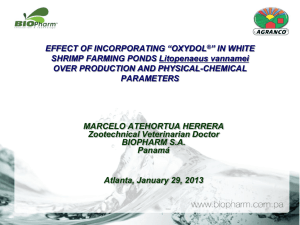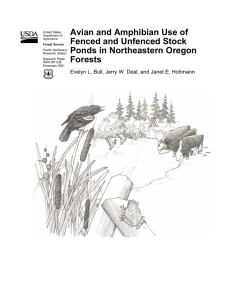fwb12402-sup-0001-AppendixS1-TableS1-S3
advertisement
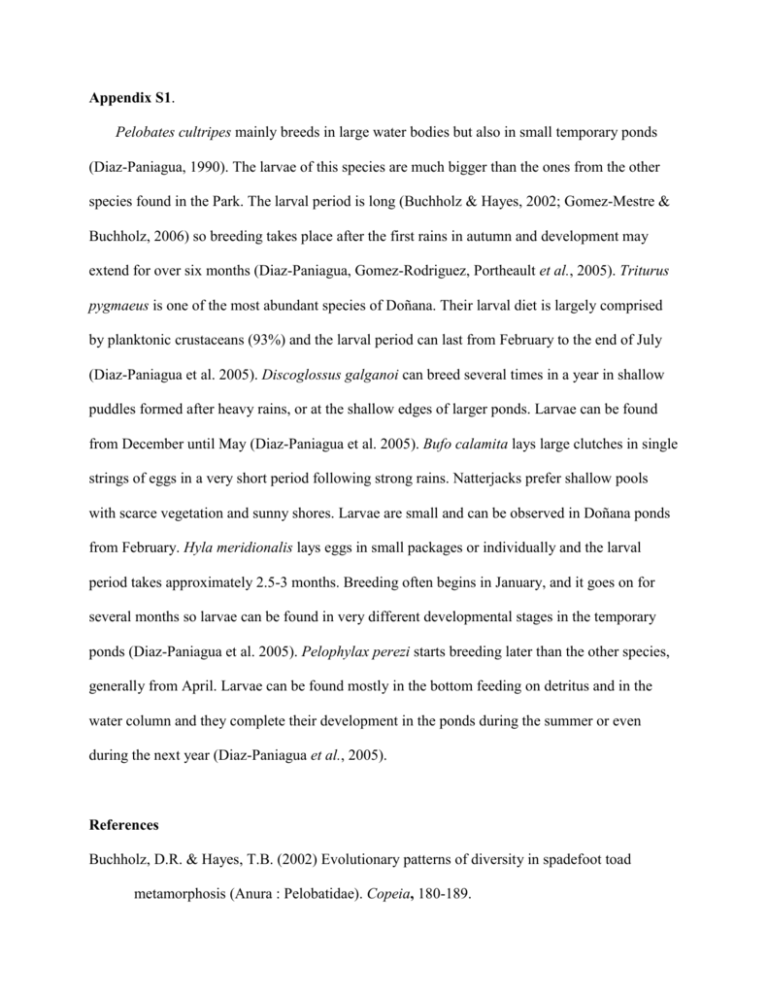
Appendix S1. Pelobates cultripes mainly breeds in large water bodies but also in small temporary ponds (Diaz-Paniagua, 1990). The larvae of this species are much bigger than the ones from the other species found in the Park. The larval period is long (Buchholz & Hayes, 2002; Gomez-Mestre & Buchholz, 2006) so breeding takes place after the first rains in autumn and development may extend for over six months (Diaz-Paniagua, Gomez-Rodriguez, Portheault et al., 2005). Triturus pygmaeus is one of the most abundant species of Doñana. Their larval diet is largely comprised by planktonic crustaceans (93%) and the larval period can last from February to the end of July (Diaz-Paniagua et al. 2005). Discoglossus galganoi can breed several times in a year in shallow puddles formed after heavy rains, or at the shallow edges of larger ponds. Larvae can be found from December until May (Diaz-Paniagua et al. 2005). Bufo calamita lays large clutches in single strings of eggs in a very short period following strong rains. Natterjacks prefer shallow pools with scarce vegetation and sunny shores. Larvae are small and can be observed in Doñana ponds from February. Hyla meridionalis lays eggs in small packages or individually and the larval period takes approximately 2.5-3 months. Breeding often begins in January, and it goes on for several months so larvae can be found in very different developmental stages in the temporary ponds (Diaz-Paniagua et al. 2005). Pelophylax perezi starts breeding later than the other species, generally from April. Larvae can be found mostly in the bottom feeding on detritus and in the water column and they complete their development in the ponds during the summer or even during the next year (Diaz-Paniagua et al., 2005). References Buchholz, D.R. & Hayes, T.B. (2002) Evolutionary patterns of diversity in spadefoot toad metamorphosis (Anura : Pelobatidae). Copeia, 180-189. Diaz-Paniagua, C. (1990) Temporary ponds as breeding sites of amphibians at a locality in southwestern Spain. Herpetological Journal, 1, 447-453. Diaz-Paniagua, C., Gomez-Rodriguez, C., Portheault, A. & De Vries, W. (2005) Los anfibios de Doñana. Gomez-Mestre, I. & Buchholz, D.R. (2006) Developmental plasticity mirrors differences among taxa in spadefoot toads linking plasticity and diversity. Proceedings of the National Academy of Sciences of the United States of America, 103, 19021-19026. Table S1. Chemical parameters measured in tanks at the end of the experiment: Turbidity (NTU), Chlorophyll-a (μg L-1), Shannon Diversity Index for the zooplankton (cladocerans, copepods, rotifers, and ostracods), total final plant biomass remaining in the tanks (g), total plant biomass after re-flooding (g), dissolved oxygen in the water (mg L-1), conductivity (mS cm-1) and four dissolved nutrients (ammonium, phosphate, nitrate and nitrite, ppb). Data represent mean ± se for every treatment (number of replicates per treatment, N=12, except for Low and NatC, N=11). Treatment No Amph Low High No Pc NatC NatF InvC InvF 10.49 ± 4.16 38.43 ± 11.1 67.21 ± 18.87 4.85 ± 2.09 24.79 ± 5.32 27.79 ± 6.97 21.84 ± 8.42 116.17 ± 29.23 11.57 ± 3.23 11.30 ± 1.82 20.57 ± 4.33 16.55± 5.71 11.75 ± 1.40 13.64 ± 2.66 13.26 ± 2.79 20.22 ± 4.07 Zoo Shannon Div. 1.70 ± 0.1 1.51 ± 0.08 1.28 ± 0.06 1.56 ± 0.08 1.50 ± 0.15 1.47 ± 0.09 1.46 ± 0.12 1.57 ± 0.06 Total Plants (g) Total Plants reflooding (g) Diss. Oxygen (mg L-1) 404.34 ± 29.23 198.88 ± 37.06 58.69 ± 21.44 584.78 ± 75.51 262.03 ± 38.65 329.59 ± 48.95 261.78 ± 31.98 13.27 ± 3.91 80.10 ± 9.81 32.81 ± 7.46 19.71 ± 3.51 88.62 ± 7.87 24.56 ± 4.58 35.33 ± 9.16 30.93 ± 8.22 10.58 ± 2.21 8.57 ± 0.37 7.28 ± 0.37 6.47 ± 0.35 8.69 ± 0.35 7.67 ± 0.4 7.92 ± 0.39 7.53 ± 0.23 4.75 ± 0.24 Conductivity (mS cm-1) 0.25 ± 0.01 0.29 ± 0.01 0.33 ± 0.01 0.29 ± 0.02 0.30 ± 0.01 0.27 ± 0.01 0.29 ± 0.01 0.35 ± 0.02 Ammonium (ppb) 29.52 ± 4.76 71.32 ± 26.35 60.86 ± 14.41 26.98 ± 4.7 95.92 ± 51.08 47.86 ± 9.27 37.38 ± 6.86 240.4 ± 72.4 Phosphate (ppb) 20.95 ± 1.71 16.72 ± 2.1 20.78 ± 2.33 9.26 ± 0.94 22.68 ± 3.96 13.18 ± 2.09 15.14 ± 3.28 22.19 ± 3.08 Nitrate (ppb) 9.3 ± 2.81 10.96 ± 3.53 8.21 ± 1.53 11.1 ± 1.64 8.97 ± 1.26 6.87 ± 1.14 11.31 ± 2.45 9.61 ± 1.21 Nitrite (ppb) 4.13 ± 0.23 4.52 ± 0.66 7.64 ± 3.04 3.32 ± 0.17 10.9 ± 6.07 4.46 ± 1.21 3.83 ± 0.43 10.74 ± 3.08 Turbidity (NTU) Chlorophyll-a (μg L ) -1 Table S2. Statistical results of the GLMM to test the effect of amphibians on different ecological variables of temporary ponds. We used five different contrasts to test for such effects. Degrees of freedom (df), F value (F) and p value (p) are shown for every contrast. Numerator df was equal to 1 in all statistical contrasts and therefore not shown in the table. Effects of amphibians on temporary ponds Turbidity Oxygen Conductivity Ammonium Phosphate Nitrite Nitrate Macrophytes Macrophytes after reflooding Chlorophyll-a Zooplankton Shannon Diversity df F p df F p df F p df F p df F p df F p df F p df F p df F p df F p df F p No Amph Low No Amph -High Low - High No Amph No Pc Low – No Pc 86 10.85 0.0024 75 10.91 0.0015 86 5.95 0.031 78 2.89 0.0932 78 1.77 0.1871 78 0.02 0.889 78 2.26 0.137 86 14.95 0.00025 75 25.34 0.00021 78 0.39 0.5319 85 1.95 0.166 86 20.58 0.0002 75 27.38 0.0001 86 19.42 0.0005 78 1.59 0.2105 78 0.01 0.9075 78 0.39 0.5361 78 0.00 0.9997 86 64.84 0.00014 75 47.27 0.00021 78 4.84 0.0308 85 9.61 0.0026 86 1.31 0.2564 75 3.25 0.0755 86 3.5 0.0649 78 0.22 0.6415 78 1.48 0.2272 78 0.56 0.4576 78 2.26 0.1369 86 16.07 0.00014 75 2.81 0.0981 78 2.31 0.1329 85 2.67 0.1057 86 1.02 0.3157 75 0.1 0.7496 86 3.06 0.0838 78 0.67 0.416 78 8.07 0.017 78 2.22 0.1402 78 0.00 0.9997 86 4.42 0.0385 75 0.83 0.3644 78 0.39 0.5341 85 0.99 0.3223 86 18.33 0.0002 75 13.07 0.0006 86 0.53 0.4679 78 6.24 0.0029 78 8.07 0.017 78 1.73 0.1926 78 2.26 0.1369 86 35.08 0.00014 75 35.1 0.00021 78 0 0.9853 85 0.18 0.6731 Table S3. Statistical results of the GLMM to test the effect of native and invasive predators on different ecological variables of temporary ponds. We used seven different contrasts to test for such effects. Degrees of freedom (df), F value (F) and p value (p) are shown for every contrast. Numerator df was equal to 1 in all statistical contrasts and therefore not shown in the table. Effects of predators Turbidity Oxygen Conductivity Ammonium Phosphate Nitrite Nitrate Macrophytes Macrophytes after reflooding Chlorophyll-a Zooplankton Shannon Diversity df F p df F p df F p df F p df F p df F p df F p df F p df F p df F p df F p Low - NatC Low - Nat F Low - InvC Low - InvF 86 0.57 0.4535 75 1 0.3198 86 0.1 0.7548 78 0.7 0.4047 78 1.19 0.2797 78 0.76 0.3852 78 2.16 0.1461 86 1.86 0.1763 75 1.12 0.2939 78 0.05 0.8307 85 0 0.9843 86 0.38 0.54 75 3.02 0.0866 86 1.07 0.3041 78 1.36 0.2464 78 1.8 0.1842 78 1.08 0.3012 78 0.02 0.8917 86 6.66 0.0128 75 0.01 0.928 78 0.17 0.6847 85 0.05 0.8287 86 3.24 0.0754 75 0.62 0.4338 86 0.03 0.8721 78 1.19 0.2781 78 0.88 0.3513 78 0.61 0.436 78 2.26 0.1369 86 2.36 0.1284 75 0.05 0.8325 78 0.05 0.8159 85 0.12 0.729 86 5.46 0.0218 75 35.89 0.0001 86 5.55 0.031 78 3.25 0.0752 78 1.68 0.1986 78 4.52 0.0366 78 2.26 0.1369 86 32.65 0.00014 75 11.5 0.00154 78 2.16 0.1461 85 0.25 0.6216 NatC NatF 86 0.02 0.8781 75 0.51 0.4794 86 1.83 0.1793 78 0.1 0.7571 78 6.02 0.0246 78 3.74 0.0567 78 1.87 0.1758 86 1.41 0.2384 75 1.38 0.2445 78 0.04 0.8513 85 0.04 0.8444 InvC InvF 86 17.89 0.0002 75 48.25 0.0001 86 5.04 0.0328 78 8.8 0.004 78 5.24 0.0297 78 8.89 0.0057 78 0.00 1.00 86 54.94 0.00014 75 10.61 0.002 78 1.6 0.2096 85 0.73 0.3957

